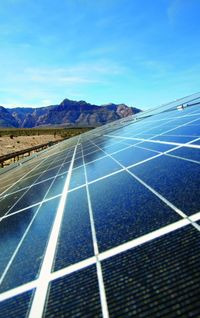Greenbacker Renewable Energy has used innovative financing mechanisms to take full advantage of tax incentives from the Inflation Reduction Act. Transactions were tailored around transferability and a bonus tax credit. By Alison Healey
Greenbacker Renewable Energy Company (GREC) is a US-based independent power producer that generates power, invests in power generation technology and sells power to public and private offtakers. Greenbacker’s IPP business segment acquires, owns, and operates a fleet of over 400 clean energy assets diversified across solar, wind and energy storage that provide power under long-term contracts to counterparties that include utilities, municipalities, and corporations.
GREC was founded in 2011 and bought its first commercial wind asset in 2015 – the 10MW Fairfield project in Montana. Since then, it has amassed a portfolio of 3.2GW. In 2024, the company placed 22 new projects into service and closed on a series of financing transactions. Earlier this year, Macquarie Group’s asset management arm put up US$85m in financing for five solar projects in Ohio and Illinois.
Some key executives include CEO Charles Wheeler, Carl Weatherley-White, and Chris Smith. Prior to joining the company in 2011, Wheeler held various senior positions in his 24-year career with Macquarie Group, including head of renewables for North America.
Weatherley-White is head of capital markets, overseeing tax equity and project financing for GREC’s pre-operational asset fleet and pursuing opportunities to optimise GREC’s existing capital structure within the evolving infrastructure capital markets. He previously served as head of renewable investments at Advantage Capital where he led the creation of the firm’s renewable energy tax credit syndication platform and was involved in originating and structuring over US$1.5bn in tax credit investments. He has prior experience as group head of global project finance at Barclays Capital.
Chief financial officer Chris Smith has over 20 years of accounting and finance experience and previously served as partner and CFO at sustainability-focused private equity firm SER Capital Partners. He has prior experience as managing director and treasurer at Hannon Armstrong Sustainable Infrastructure.
In a significant repowering deal in 2024, Greenbacker took three wind energy assets offline during portions of Q3 2023 to retrofit with updated, US-made components. Greenbacker secured US$437m in financing to repower the 110MW portfolio of wind assets: two utility-scale assets in Iowa and its largest wind farm in Minnesota. The projects qualify for the 30% investment tax credit and were among the industry’s first to utilise the additional 10% domestic content bonus newly created by the IRA.
Greenbacker collaborated with existing lender Bayerische Landesbank on US$81.5m in construction bridge loan facilities and Huntington National Bank led long-term debt and tax equity financing via sale-leasebacks totalling US$355.7m. The deal represented Greenbacker’s first executed sale-leasebacks. The structure provides greater upfront proceeds while capturing the benefits of tax equity financing and back leverage lending in one transaction.
Greenbacker faced the challenge of creating a new legal framework for the deal and providing sufficient documentation to qualify for the bonus tax credit. Both required coordination and execution between the Greenbacker and Huntington legal teams of Stoel Rives and Norton Rose Fulbright, respectively. Successfully qualifying for the domestic content adder enabled Greenbacker to extract additional value from existing assets and provided a template for future projects that can benefit from similar transaction structures.
The transaction faced logistical challenges associated with the repowering of existing wind assets. The assets involved were already operational and generating revenue, which meant that taking them offline for repowering posed risks, as delays or complications in the repowering process could cause prolonged downtime, impacting revenue. The repower financing transaction and repower construction also faced an additional challenge: both had to be completed within the 90-day completion window mandated by IRS guidelines for sale-leaseback transactions. Each turbine had to be disassembled, upgraded, and reassembled within this timeframe, requiring a coordinated effort across all operational parties, and the financing needed to make it to close.
Bedrock Renewables led the development of the repowerings and supported the financings on behalf of Greenbacker. All three facilities returned to full operation by late 2023 and early 2024. Work was completed at Greenbacker’s 30MW Community Wind South project in Minnesota and 42.5MW Elk wind asset in Iowa in late 2023. The repower at the 37.5MW Hawkeye wind project in Iowa was completed in Q1 2024.
The company recently closed on US$869.9m in financing to back the 685MW Cider solar project in Genesee County, New York. The financing includes a US$417.8m bridge loan due October 2027, a US$200m term loan due October 2032 and priced at 212.5bp over SOFR, a US$172.6m term loan due October 2037 and priced at 150bp, and a US$79.5m standby letter of credit due October 2037.
Administrative agents include Keybank and MUFG, Wells Fargo served as an arranger, and syndication agents were ING, Intesa Sanpaolo, and Societe Generale. The project was developed with Hecate Energy who put prior financing in place in 2023. The electricity produced by the facility will be delivered to the local distribution grid after interconnection into a transmission line owned by New York Power Authority.
Cider Solar is supported by a robust 20-year renewable energy standard agreement with New York State Energy Research & Development Authority (NYSERDA). The term debt was structured to be fully amortising over the 20-year contracted tenor plus a certain merchant tail. The project used the transferability provision of the IRA enabling the project to obtain financing for construction and long-term operations before securing a commitment from a tax equity investor or a tax credit purchaser. MUFG anchored the financing with a commitment of US$265m.
Greenbacker was recently selected for contracts on four of 23 new renewables projects totalling 2.3GW via the NYSERDA’s 2023 Tier 1 Renewable Energy Standard solicitation. The contracts will go to Cider as well as its Little Pond, Tayandenega, and Rock District solar schemes.
In another notable deal the company closed on US$158.8m in financing for the 59MW Moscow wind project in Somerset County, Maine. Moscow Wind had an eight-year wind proxy revenue put that provides insurance against low-wind speeds regardless of the project's actual performance, guaranteeing energy generation and production-based revenue using a proxy generation index. Climate insurance provider kWh Analytics advised on the hedge that was provided by reinsurer Munich Re.
"This implementation marks the first time a parametric wind hedge has been paired with the kWh Analytics indifference structure to reduce equity requirements for a project sponsor," kWh Analytics said, adding that the structure enabled the project sponsor to raise roughly 20% more debt capital for the project.
The wind proxy hedge paired with the indifference structure addressed wind speed volatility, improving the project’s P99 scenario by adding investment-grade cashflow above the P99 wind speed. The credit enhancement can make the project more attractive to lenders, leading to increased debt capacity. By incorporating the wind proxy hedge and kWh indifference structure, each dollar of premium paid for the product resulted in US$6 of additional loan proceeds.
MUFG served as administrative agent on the loan, which includes a US$49.7m transferability bridge loan due 2025 and US$96.1m term loan and US$12.9m standby letter of credit, both due 2034. The project has a 25-year power purchase agreement with eight municipalities connected to ISO New England and the Massachusetts Development Finance Authority. It is expected to be completed in March 2025 with turbines supplied by Vestas. Latham & Watkins was legal adviser to MUFG.
Greenbacker has executed nine power purchase agreements with eight municipalities in ISO-New England and the Massachusetts Development Finance Authority for 100% of the project’s capacity. The PPAs cover its energy, capacity, renewable energy credits, and other environmental attributes.
The transferability bridge loan was structured assuming a US$0.90 transfer price with an advance rate of 98%, or 88.2% of the investment tax credit value, excluding any bonus credits. The availability under the bridge loan will be limited to 75%, or 67.5% of the ITC value until the buyer of the credits is identified. In order to ensure the project is fully funded, Greenbacker’s equity will remain in the project.
The Greenbacker Capital Management (GCM) division manages direct investments in renewable energy, pairing individual investors' capital with opportunities to fund profitable sustainable infrastructure projects. GCM provides fund formation, capital raising, asset acquisition, financing, consulting, and development capabilities investment advisory. As of 2024, GCM serves as the registered investment adviser to four energy transition-focused funds, including Greenbacker Development Opportunities Fund, which invests development and growth capital into sustainable infrastructure developers.
In one example of a recent investment GCM provided US$100m in capital to Virginia-based energy storage developer Lightshift Energy. A total of US$20m came from a GCM-affiliated investment vehicle dedicated to making growth equity investments in sustainable infrastructure development platforms. The funds were designated to expand Lightshift’s team, accelerate sales and grow its pipeline. Another US$80m came from a second GCM-affiliated investment vehicle that invests in sustainable infrastructure assets that will support the construction and operations of Lightshift’s portfolio.
The commitments build on Greenbacker’s initial equity investment in the company in 2021, a US$20m investment from Greenbacker Development Opportunities Fund. Lightshift has developed more than 20 battery projects to date and has a pipeline in excess of 4GW.
Greenbacker said in a white paper posted to its website that it has faced questions from investors about how the political landscape could affect energy transition investment. The company believes the momentum behind clean energy “remains strong, driven by legislative support and economic realities”, and “is poised to continue its growth, particularly given policy tailwinds that are unlikely to disappear”, despite a political shift.
Greenbacker said investors can feel confident that the energy transition is “largely resilient” in the face of political cycles. “Although the 2024 US presidential election will undoubtedly shape political discourse, we do not believe it will have a profound impact on the trajectory of energy transition investment”, Greenbacker said.
“The legislative strength of the IRA, the economic benefits to red states, and the practical realities of renewable energy growth all suggest that the clean energy sector will continue to thrive, regardless of who sits in the White House”.
To see the digital version of this report, please click here.
To purchase printed copies or a PDF of this report, please email leonie.welss@lseg.com














